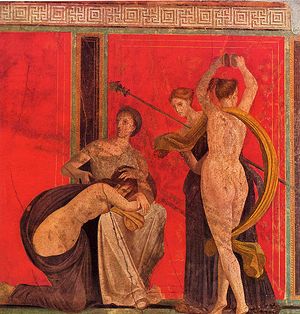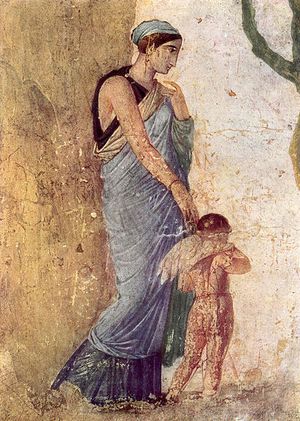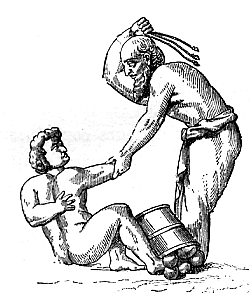Antiquity: Difference between revisions
(Created page with "{{Page-ok|09/20}}{{Header|Antiquity 09/20}} thumb|[[Nemesis leads Amor, bound on hands and feet, to Venus. Detail from a fresco in...") |
m (Text replacement - " Ancient Greece" to " Ancient Greece") |
||
| (3 intermediate revisions by the same user not shown) | |||
| Line 1: | Line 1: | ||
{{Header|Antiquity 09/20}} | |||
[[Image:Pompeji punished amor.jpg|thumb|[[Nemesis]] leads [[Amor]], bound on hands and feet, to [[Venus]]. Detail from a fresco in Pompeii (c. AD 30).]] | [[Image:Pompeji punished amor.jpg|thumb|[[Nemesis]] leads [[Amor]], bound on hands and feet, to [[Venus]]. Detail from a fresco in Pompeii (c. AD 30).]] | ||
| Line 22: | Line 22: | ||
Adults were usually whipped on their backs while [[bondage|restrained]], e.g. to a whipping pillar. Adult whippings were ''very'' severe and [[cruel]]. | Adults were usually whipped on their backs while [[bondage|restrained]], e.g. to a whipping pillar. Adult whippings were ''very'' severe and [[cruel]]. | ||
In addition, there was also non-punitive whipping in the Roman Empire, such as on the festival of [[Lupercalia]] (February 15) where girls and women would line up in the streets to receive whippings from young male priests called ''Luperci'' with [[strap]]s made from a sacrificed goat's skin. This ritual was supposed to ensure fertility and ease the pains of childbirth. | In addition, there was also non-punitive whipping in the Roman Empire, such as on the festival of [[Lupercalia]] (February 15) where girls and women would line up in the streets to receive whippings from young male priests called ''Luperci'' with [[strap]]s made from a sacrificed goat's skin. This ritual was supposed to ensure [[fertility]] and ease the pains of childbirth. | ||
In Ancient Greece, the [[Sparta|Spartiates]] are most infamous for their tough childrearing methods. | In [[Ancient Greece]], the [[Sparta|Spartiates]] are most infamous for their tough childrearing methods. | ||
== Spanking implements in antiquity == | == Spanking implements in antiquity == | ||
| Line 58: | Line 58: | ||
* [http://laudatortemporisacti.blogspot.com/2004/09/plagosus-orbilius.html Laudator Temporis Acti: Plagosus Orbilius] | * [http://laudatortemporisacti.blogspot.com/2004/09/plagosus-orbilius.html Laudator Temporis Acti: Plagosus Orbilius] | ||
{{ | {{cat|Settings|History}} | ||
Latest revision as of 10:06, 20 August 2023
Antiquity is a historic period in Europe and the Mediterranean area from around the 8th century BC to the fall of the Roman Empire in the 5th century AD. The most notable civilisations of antiquity were Ancient Greece and Ancient Rome.
Antiquity was succeeded by the Middle Ages.
Corporal punishment in antiquity

Corporal punishment was an everyday sight in Antiquity. It was common in the forms of:
- judicial corporal punishment
- military corporal punishment
- corporal punishment of slaves
- corporal punishment of children:
- in the home (domestic corporal punishment)
- in schools and by private teachers and tutors (school corporal punishment)
- folkloristic spanking traditions
A recipient of corporal punishment was always made naked in antiquity, even students in schools - a beating over the clothing was not thought to be effective, and a person to be punished had no right for modesty. School lessons usually took place outdoors, so school CP was always more or less public. Students were beaten on their backs, buttocks or hands.
Adults were usually whipped on their backs while restrained, e.g. to a whipping pillar. Adult whippings were very severe and cruel.
In addition, there was also non-punitive whipping in the Roman Empire, such as on the festival of Lupercalia (February 15) where girls and women would line up in the streets to receive whippings from young male priests called Luperci with straps made from a sacrificed goat's skin. This ritual was supposed to ensure fertility and ease the pains of childbirth.
In Ancient Greece, the Spartiates are most infamous for their tough childrearing methods.
Spanking implements in antiquity
The Greek had the following spanking implements:
The Romans had the following whipping and spanking implements such as:
- the virga - a birch rod or similar implement (such as a bundle of leather strips).
- the ferula - a cane
- the lorum - a leather strap
- the flagrum - a whip with two or three lashes with small metallic dumbbells on the pointslashes
- the flagellum - a whip similar to the flagrum but smaller
- the scutica - a whip with twisted parchment thongs
- switches made of elm, vine, laurel or myrtle
Professional whippers were called lictor or carnifex. A man who wielded the virga was called virgator, a man who used the lorum was called lorarius.
Several authors described the details of Roman punishments, such as Horace, Martial and in particular Saint Augustine.

